Updated January 15, 2018
County health briefs offer comprehensive information about Tennessee cities and their surrounding areas. Each county health brief is different and focuses on that county’s biggest health challenges as identified by county and city health departments. Due to the highly customized nature of this information, statistics and metrics will vary from brief to brief.
The Nashville & Davidson County health brief focuses on the top health priorities as identified by local experts, including representatives from the Metro Public Health Department. Find source information at the bottom of this page.
Scroll down to read about health in Davidson County or jump to a specific section:
What are the demographics of Davidson County?
Population
691,243
Density: 1,315 people per square mile
Population growth: Has been growing steadily since 2010
Davidson County population growth 2008-17
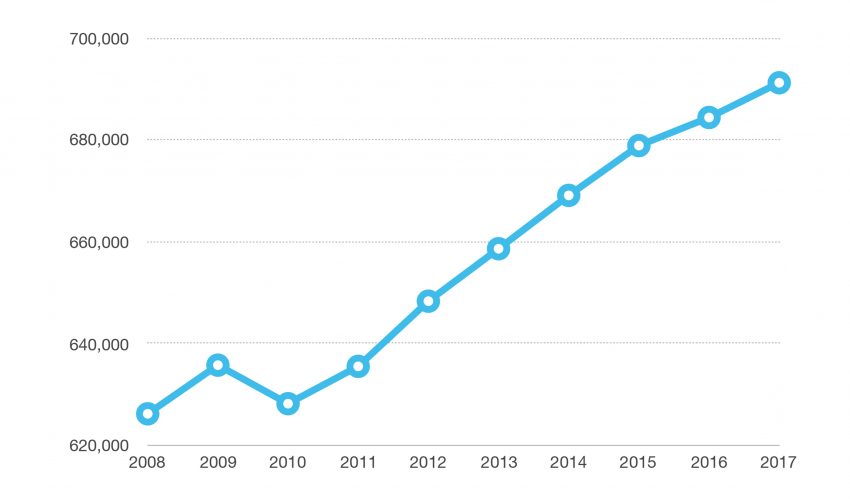
Age
The median age in Davidson County is 34.
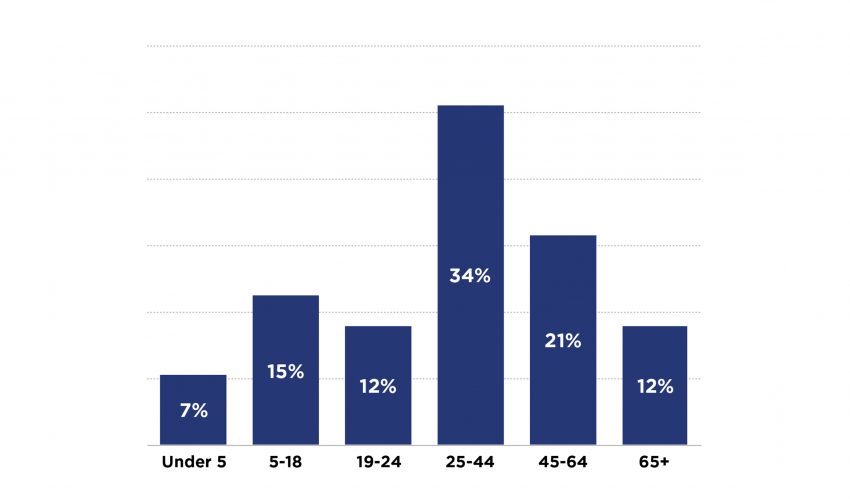
Sex
Female: 52%
Male: 48%
Race
White: 56%
Black: 28%
Hispanic: 10%
Asian: 3.7%
Multiple: 2.3%
12% of Nashville’s population was not born in the U.S, which is significantly higher than Tennessee’s rate of 5% foreign-born residents.
Life expectancy
78 years for women
74 years for men
Those numbers are:
- Comparable to Tennessee’s life expectancy but
- Below the life expectancy for the U.S. as a whole
- 81 years for women
- 77 for men
Health index
Davidson County scores 0.926 in the BlueCross Health Index where 0.867 is less healthy and 0.970 is healthier.
The index measures the impact of more than 200 common diseases and conditions on overall health and wellness by assigning each county in the United States a health metric between 0 and 1, designating the proportion of optimal health reached by the county’s population. For example, a measurement of 0.9 indicates that, on average, the population of a county is living at 90% of its optimal health. In other words, the county population could gain up to 10% in healthy lifespan by addressing the top health conditions impacting their area.

What are the most common causes of death in Davidson County?
The top 10 causes of death in Davidson County are:
- Heart disease
- Cancer
- Accidents
- Lung disease
- Stroke
- Alzheimer’s disease
- Diabetes
- Influenza/pneumonia
- Suicide
- Liver disease and cirrhosis
Leading causes of death in Davidson County, 2013
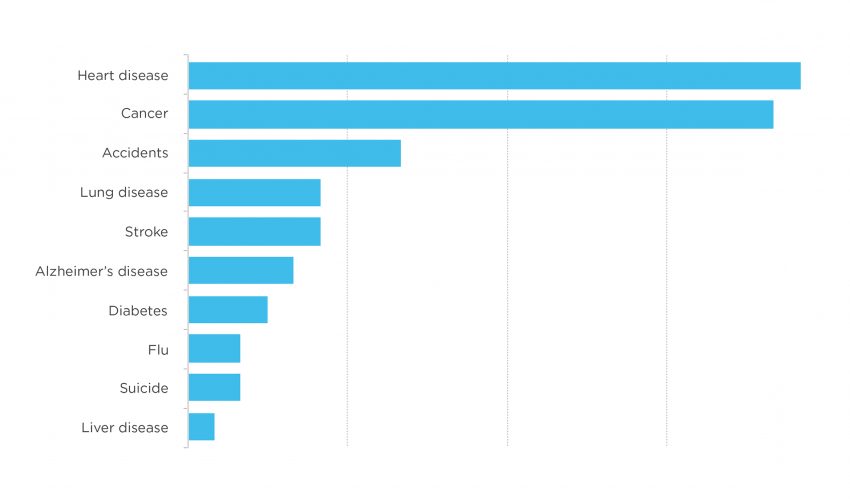
What are the most common diseases in Davidson County?
Chronic diseases
Cancer
In general, cancer is less common in Davidson County than in the rest of the state but more common than in the U.S.
- Breast cancer is more common in Davidson County than in the rest of the state or nation, while
- Colorectal cancer is less common.
Obesity
30% of Davidson County residents are obese compared to:
- 31% of Tennesseans, and
- 40% of Americans.
36% of children in Nashville are obese, however only 24% perceive themselves as overweight.
Diabetes
The rate of diabetes in Davidson County is 11.2%, which is:
- Lower than the Tennessee rate of 12.7% but
- Higher than the nationwide rate of 9.4%.
Heart disease
The rate of heart disease deaths in Davidson County is 372 per every 100,000 people which is:
- Lower than the state rate of 398 but
- Higher than the national rate of 327.
Addiction
The 3 most abused substances in Tennessee are:
- Alcohol
- Opioids
- Marijuana
Alcohol
8.3% of Nashville residents are dependent on or abusing alcohol or drugs, which is higher than Tennessee’s rate of 7.1%.
Drugs
In 2016, the Nashville/Davidson region had record high rates of overdose deaths.
Since 2012, the rate of overdose deaths related to all drugs as well as opioid-specific overdoses have more than doubled.
Drug overdose deaths vs. opioid overdose deaths
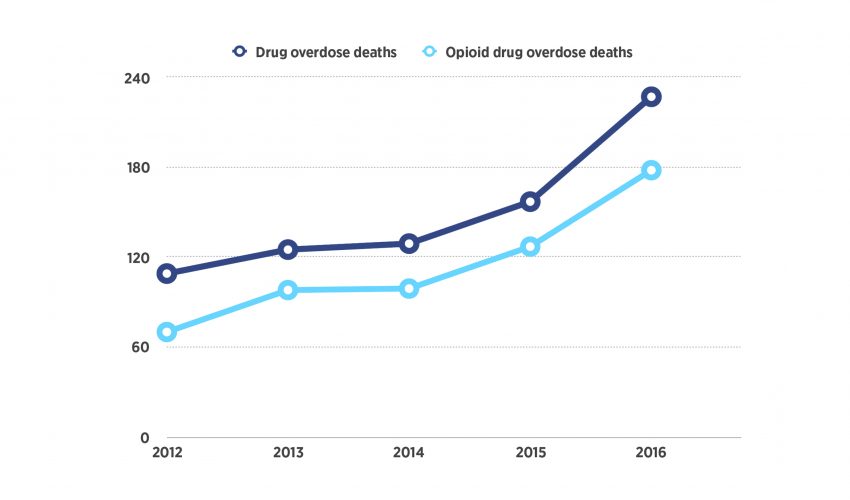
Smoking
21% of adults in Davidson County are current smokers, which is:
- Lower than the state average of 24.3%, but
- Higher than the national average of 18%.
Youth
- 90% of smokers start before age 18.
- 54% of Davidson County youth are exposed to secondhand smoke in their homes.
- 21% are current tobacco users.
In 2017:
- Many apartment complexes went smoke-free, and
- Asthma visits to the ER decreased.
Asthma & allergies
Nashville was ranked #27 in metropolitan areas in the U.S. where pollen sufferers find it challenging to live due to high pollen counts.
Alzheimer’s Disease & dementia
More than 11% of Davidson County residents suffer from Alzheimer’s or dementia, which is higher than the U.S. and state rates of roughly 10%.
Disability
31% of veterans in Davidson County have a disability, which is 3X the rate among non-veterans.
Infectious diseases
HIV/AIDS
New cases of HIV have decreased in Davidson County in recent years, but with 212 new cases diagnosed annually, it is still a public health issue. 57.7 of every 100,000 people in Davidson County are living with an HIV diagnosis.
Rate of people living with HIV, 2015
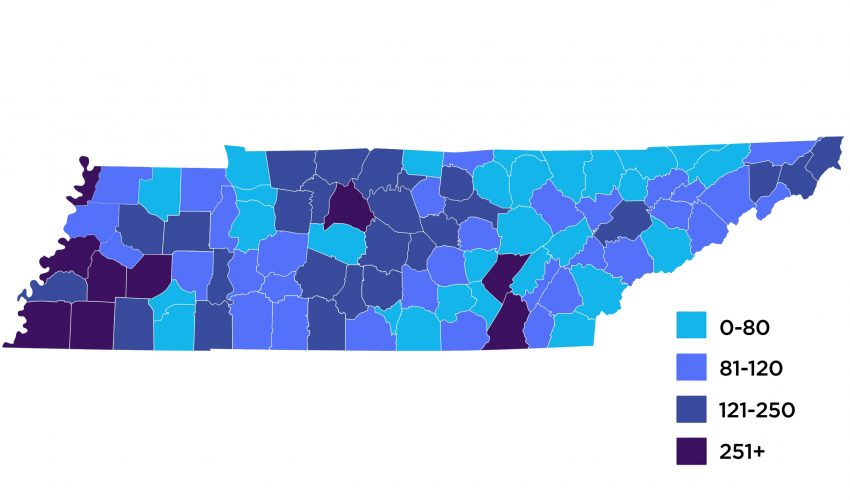
What social determinants and health disparities affect Davidson County?
Childhood
Infant mortality
Infant mortality is the number of children who die before turning one. In Davidson County, infant mortality is 7.6 per 1,000 births, which is:
- Lower than the state rate, but
- Higher than the national rate.
- The rate for African Americans in Davidson County is 5X higher.
Sleep-related deaths
Inadequate housing is a contributor to infant death due to overcrowding and unsafe sleep environments.
In 2016, the number of infants who suffocated while sleeping dropped 29% in one year. Sleep-related deaths decreased to 1 in 5 of all infant deaths.
Pregnancy
- A higher percentage of women smoke during pregnancy in Nashville than in the U.S.
- 55% of women in Davidson County receive prenatal care in the first trimester, which is far lower than the 74% who do in the U.S.
Teen pregnancy
The teen pregnancy rate in Davidson County is 12.8%, which is
- Lower than the state rate (14%) and
- Higher than the U.S. rate (11%)
Nearly 50% of teens report being sexually active.
Education
Graduation
High school graduates (age 25+)
- 87% of Nashville residents have graduated high school, which is
- Higher than state and national rates (near 85%).
College graduates (age 25+)
- 37% of Nashville residents have a bachelor’s degree or higher, which is
- Significantly higher than the Tennessee rate of 25% and the U.S. rate of 30%.
Income after graduation
The Tennessee Higher Education Commission found that Tennessee students:
- Who went straight into the workforce after high school earned an average annual salary of $10,171, however
- According to census data, they would need to earn $38,000 a year to afford the median rent in Nashville.
Unemployment
The unemployment rate in Davidson County has been steadily declining since 2010.
Transit
Nashville’s rate of walking, biking or using public transit to get to work is higher than Tennessee’s rate but lower than national rates.

Walking and biking incorporate exercise into a commute, but efficient, accessible public transportation also helps decrease obesity. The longer people sit in traffic, the longer they are inactive.
Crime
Child abuse
Reported cases of child abuse in Davidson County (4.1%) remain lower than the state rate (4.9%), however they have increased from a low of 3.1% in 2010.
Neglect
The rate (4.2%) of substantiated child abuse neglect charges in Davidson County is lower than the rate in Tennessee (5.4%).
Adverse Childhood Experiences (ACEs)
Adverse childhood experiences are stressful or traumatic experiences that disrupt the stability children need to thrive. They include abuse, neglect and dysfunction at home and can cause serious health and social issues later in life including violence and incarceration.
Juvenile crimes
Nashville’s rate of drug-related arrests for kids under 18 is much higher at 6.2/1,000 than Tennessee’s rate of 2.4.
Nashville has created a pre-arrest diversion program to address youth violence.
Domestic violence
The rate of domestic violence in Davidson County is 14.9 per every 1,000 people, which is higher than Tennessee’s rate of 10.4.
The rate has been declining from a high (17.7) in 2011.
Murder
In 2017, Nashville murders hit a 20-year high at 107.
- More than 20 homicide victims were under 19 years old.
Health care
Mental health
- 1 in 5 people (20%) in Davidson County experiences mental illness.
- 7% have experienced a major depressive episode.
A child experiencing mental health issues is more likely to have problems in school and is at greater risk of entering the criminal justice system.
Suicide
Suicide is a leading cause of death in the United States, and Nashville’s rate is comparable at 13 deaths for every 100,000 people.
- This is lower than Tennessee’s rate of 15, however
- Suicide is on the rise across the state, particularly among youth ages 10-24.
What causes health disparities in Davidson County?
Income
The median income in Davidson County is $48,368, which is
- Higher than Tennessee’s ($45,219) and
- Lower than the U.S. ($51,413)
Low-wage workers
- 37% earn less than $12 an hour, and
- 59% earn less than $15 an hour.
Wealth disparity has not improved in 50 years. Whites hold 7X the amount of wealth as blacks and 6X the amount of Hispanics.
Poverty
17% of people in Davidson County live in poverty, which is slightly higher than the state rate of 16%.
22% of children live in poverty, which is a decrease from a high of 31.5% in 2013.
The groups of people with the highest rates of poverty in Nashville are women, specifically:
- Female householders with no husband present and children under 18: 6%
- Female householders with no husband present and children under 5: 8%
- Unemployed females: 7%
Davidson County’s poverty rate and pattern of disparity by race/ethnicity is similar to that of the U.S.
Poverty by race, 2015

Food security
17.3% of the population has difficulty accessing or affording food, which is lower than Tennessee’s rate of 27%.
Food deserts in Nashville
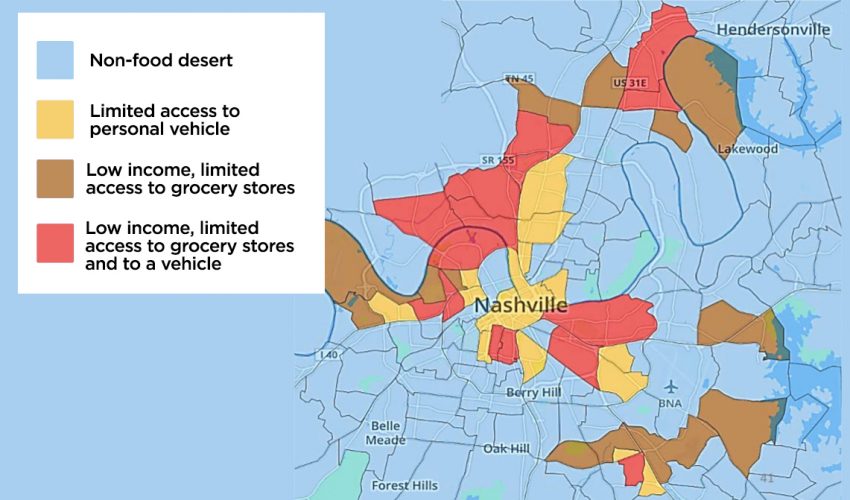
Housing
While Nashville real estate is projected to appreciate 4.3% — the highest growth rate in the nation — 18% of residents have severe housing problems, which is
- Higher than the state rate of 15.6%,
- And largely due to problems of affordability.
Half of renters spend 30% or more of their household income on rent, which is comparable to both state and national rates.
In recent years, 87% of people who entered Metropolitan Social Services were seeking help with housing.
Nashville has been ranked the city with the 6th highest rate of gentrification in the U.S, which may exacerbate affordable housing issues, especially for low-income individuals.
Needs as identified by people entering social services
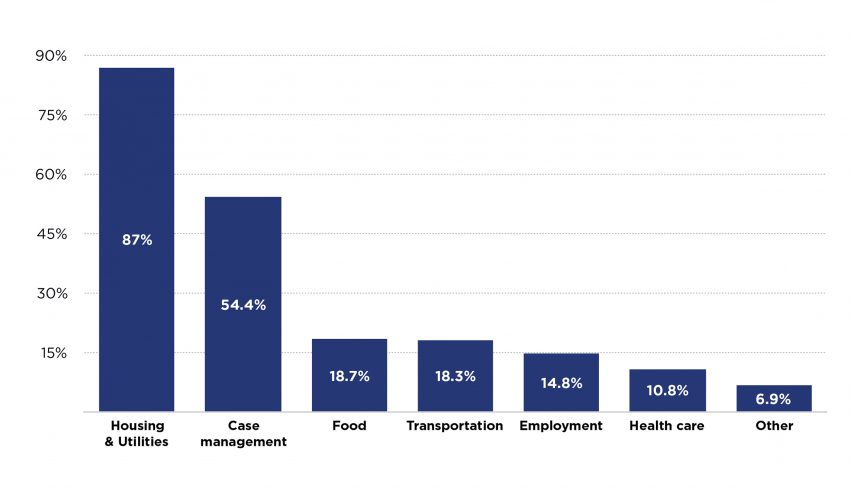
How is Davidson County addressing health challenges?
The Healthy Nashville Leadership Council and the Metro Public Health Department spearheaded efforts to create the Healthy Nashville Community Health Improvement Plan (CHIP), which is being enacted from 2015-19.
It presents 3 key issues for the community to address during the next 5 years:
- Advancing health equity
- Supporting mental and emotional health, and
- Maximizing built and natural environments.
To learn more about the plan and goals, click here.
What has BlueCross done for health in Davidson County?
The BlueCross BlueShield Health Foundation has donated:
- $1.3 million to Count It! Lock It! Drop It! to fight opioid addiction in Tennessee
- $1.8 million to support 17 KaBOOM! playgrounds in the state, which BlueCross employees helped build. Three playgrounds are in Davidson County.
- $1.2 million to 120 schools across the state for SPARK PE training and equipment
- $970,000 to Microclinic International to conduct healthy living clinics throughout Tennessee, including at Siloam Health in Nashville
- $500,000 to help fund the creation of the Country Music Hall of Fame’s Taylor Swift Education Center
- $317,277 to Faith Family Medical Center, which treats 3,500 patients per year, half of whom have diabetes, obesity or hypertension
- $150,000 to the Nashville Public Library to support the Be Well at NPL wellness program at underserved locations
- $175,000 to Rocketown to improve health literacy among the teens who visit the safe, drug- and alcohol-free space
- $100,000 to Tennessee food banks
- $50,000 to fund a Bridges to Belmont scholarship for a student studying health care
- $50,000 to The Next Door to help them provide rehabilitation for women in crisis
- $33,000 to Murfreesboro’s Howard’s Hope to provide swimming lessons to children
- $15,000 to the Nashville Food Project
Stories from Davidson County

At Centerstone, suicide prevention continues beyond the first call for help. Click the photo to read more.

At the Nashville Public Library, therapy dogs help young kids build skills, confidence and a love of reading. Click the photo to read more.

The Nashville Food Project collects food donations and encourages self-sufficiency with gardens. Click the photo to read more.

At Rocketown's recording studio, a young man finds space, freedom & support to work toward his dreams. Click the photo to read more.
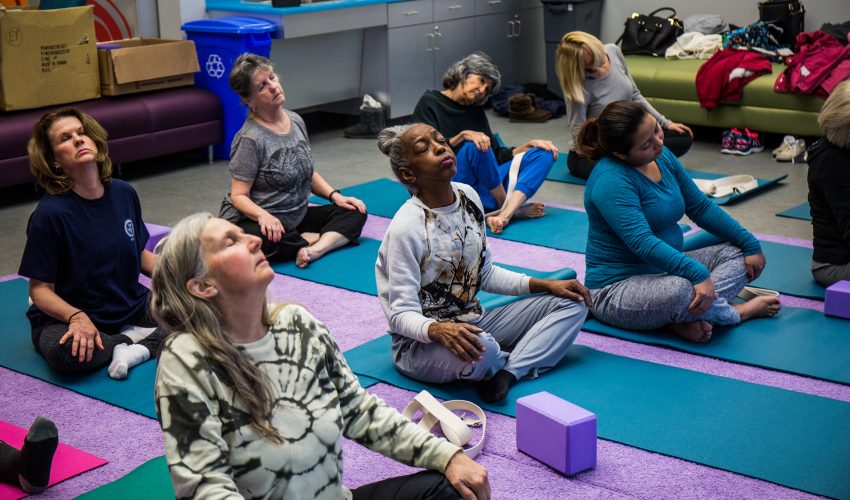
Senior yoga is just one program the Nashville Public Library offers. Click the photo to read more.
Sources
Information in this brief comes from the Metro Nashville Health Department, sources linked to within this brief and from the following reports:
- Metro Nashville-Davidson County Community Health Profile (2014)
- Davidson County Community Health Needs Assessment (2016)
- Davidson County Profile from healthdata.org
- Healthy Nashville, an initiative of the Metro Public Health Department
- Social and Economic Disparity in Nashville report by Metropolitan Social Services (2017)



